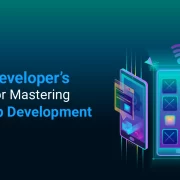
Mastering Flutter: A Comprehensive Guide to App Development in 2024
Summary
This blog outlined the various benefits, impacts, and functionalities of the Flutter mobile app development. Flutter’s cross-platform characteristics and its numerous platforms make it a perfect choice for developers and startups.
The cross-platform framework Flutter is strong and effective, making it perfect for creating mobile applications for iOS and Android. Flutter, with its single-codebase feature, can assist businesses in cutting development expenses and expediting the app creation process. It’s a favorite among developers because of its low learning curve, strong stability attributes, and superior graphics traits.
A 2022 Statista developer survey found that Flutter is the most widely used cross-platform mobile framework by developers worldwide. If you’re searching for a quick and easy way to create mobile apps with eye-catching graphics, Flutter is the ideal answer for you!
This blog outlines the various benefits, impacts, and functionalities of the Flutter mobile app in 2024 and beyond. Let’s get started!
Table of Contents:
- What is Flutter?
- Benefits of Flutter Mobile App Development
- Why is Mobile Developer Flutter a Top Choice for Start-Ups?
- Takeaway
What is Flutter?
Google developed an open-source UI software building tool called Flutter. It uses a single codebase to create cross-platform software or native apps for iOS and Android. The toolkit includes wide, adjustable widgets specifically created for unique application design requirements.
Flutter app developers can benefit from the toolkit’s troubleshooting characteristics and hot reloads, which do away with the requirement for frequent restarts, to improve its ease of use.
Also Read: How to Use Hybrid Apps to Improve Customer Engagement and Loyalty?
Benefits of Flutter Mobile App Development
Developing mobile apps with Flutter is simple, even for inexperienced developers, thanks to its multitude of characteristics. Flutter’s instant updates and real-time support help retain users. Here are some of the key benefits of the Flutter mobile app:
1. One Codebase Across Several Platforms
Writing code independently for an iOS app and an Android app takes the most time when developing a native app. Although it necessitates building distinct codebases for every app and starting from scratch twice, the end product is just one app.
With Flutter, developers can use a single codebase for building apps for a variety of platforms, such as desktop, web, iOS, and Android. Development expenditures and time are significantly reduced because separate codebases for every platform don’t need to be maintained.
2. Quick Platform UI Coding Using Pre-Made Widgets
A widget in Flutter is an element that lets you construct a user interaction with various building blocks, like fonts, buttons, and whitespace. As long as an identical set of tools is utilized, these widgets may be employed to generate a variety of designs, from basic to intricate.
Cross-platform UI development and modification—which usually takes a long time—can now be completed much more quickly with the help of the Flutter app development tools.
3. Hot Reload
Flutter’s most advanced hot reload feature for application development is one characteristic that developers all over the world have acknowledged. This revolutionary feature lets you quickly view small code improvements without having to restart the entire application, saving developers time and increasing productivity.
Developers can quickly test several designs and assess how they impact an application before deciding on the ultimate notion, thanks to hot reloading. This allows you to steer clear of downtime during testing or troubleshooting your project afterward! Assistance from a knowledgeable Flutter app developer will improve any upcoming app development projects.
4. Numerous Platform Possibilities
With this model, you can create endless possibilities for your company. Making iOS and Android applications is not in any way constrained.
It is possible to create applications for Linux, Windows, and Mac. By doing this, you can interact with customers who aren’t using smartphones. It also enhances the reach and exposure of your brand.
5. Promotes Startup Apps Without a Server
Startups can develop serverless apps by using the Flutter mobile app with Google Firebase serving as the backend. It enables a rapid development cycle that enables you to create applications within the predetermined deadlines. Mostly, this is advantageous to the startups. They benefit from quick upgrades and app releases.
Flutter is a great option for developing mobile and web apps, especially when considering costs and budgets.
6. High-end User Retention
If your iOS or Android app takes a long time to load, users are likely to remove it, which could cost you customers and put you behind the competition.
However, when you choose to create your app with Flutter, the game is played very differently. Shorter loading times guarantee that users can start using your app more quickly and reduce the likelihood that they will leave it early.
7. Ensures Increased Stability
Flutter’s delivery engines and capacity to translate code into CPU-specific ARM code make it ideal for preserving a stable user interface throughout OS updates and customizations.
With Flutter, applications operate smoothly because of its high degree of stability. While some technologies may cease supporting older versions, Flutter ensures connectivity and upholds a uniform development methodology and API. This demonstrates Flutter’s focus on integration and reuse by allowing code created in previous versions to be used in more recent applications.
Why is Mobile Developer Flutter a Top Choice for Start-Ups?
In markets where competition is fierce, startups strive to swiftly draw in new clients. As a result, meeting user needs and a quick time to market should be the top priorities for their software development.
Here are the top reasons Flutter app development services are a preferred choice, especially among start-ups.
1. Lack of Limitations on Application Creation
Developers frequently encounter code limitations and procedure obstructions while building native apps and cross-platform applications.
However, Flutter enables users to benefit from an all-around strategy and only offers the code once. Additionally, Flutter for Internet and Flutter Windows Integration let programmers launch Flutter apps in a web browser with no modification to the original code.
2. Provides a Cost-Effective Backend Solution
Most startups need a backend solution that is both cost-effective and accessible. You can choose Flutter with Firebase as your backend due to its versatile and budget-friendly features.
Numerous services, including cloud assistance, authentication-driven privacy, and accurate database support, are offered by the Google backend solution. However, if you shift to Firebase to handle your backend necessities, you can expand effortlessly and enjoy greater flexibility—a characteristic that is essential for startups.
3. Boosts the Productivity of Developers
Flutter coders are incredibly productive developers. “Hot reload” features let you alter the code and see how it changes the application in an instant. Additionally, it lets you prevent recompiling, which will ultimately save a tonne of time.
For startups, this is advantageous because they have to ensure that their updates and iterations happen quickly. The developer’s time-to-market will automatically decrease if they can code more quickly and without any problems.
Also Read: Top 7 Reasons Why You Should Choose Flutter for Mobile App Development
Takeaway
While creating a Flutter mobile app, you can use the Flutter SDK, the Dart programming language, and the many widgets available in the Flutter library for a high-end user interface and add the required functionality.
There are many advantages to using Flutter, including its speed, dependability, flexibility, and ease of use. If you’re searching for expert assistance in creating cross-platform apps, get in touch with Hurix Digital. Hurix Digital takes care of every step of the app development process, from inception to delivery, and creates high-caliber mobile apps that satisfy your requirements.

Currently serving as the Vice President of Technology Delivery Operations at HurixDigital, a prominent global provider of digital content and technology solutions for publishers, corporations, and educational institutions. With over 16 years of experience spanning EdTech and various domains, I hold certification as a SCRUM Product Owner (CSPO). My expertise includes operations, finance, and adept people management skills.



